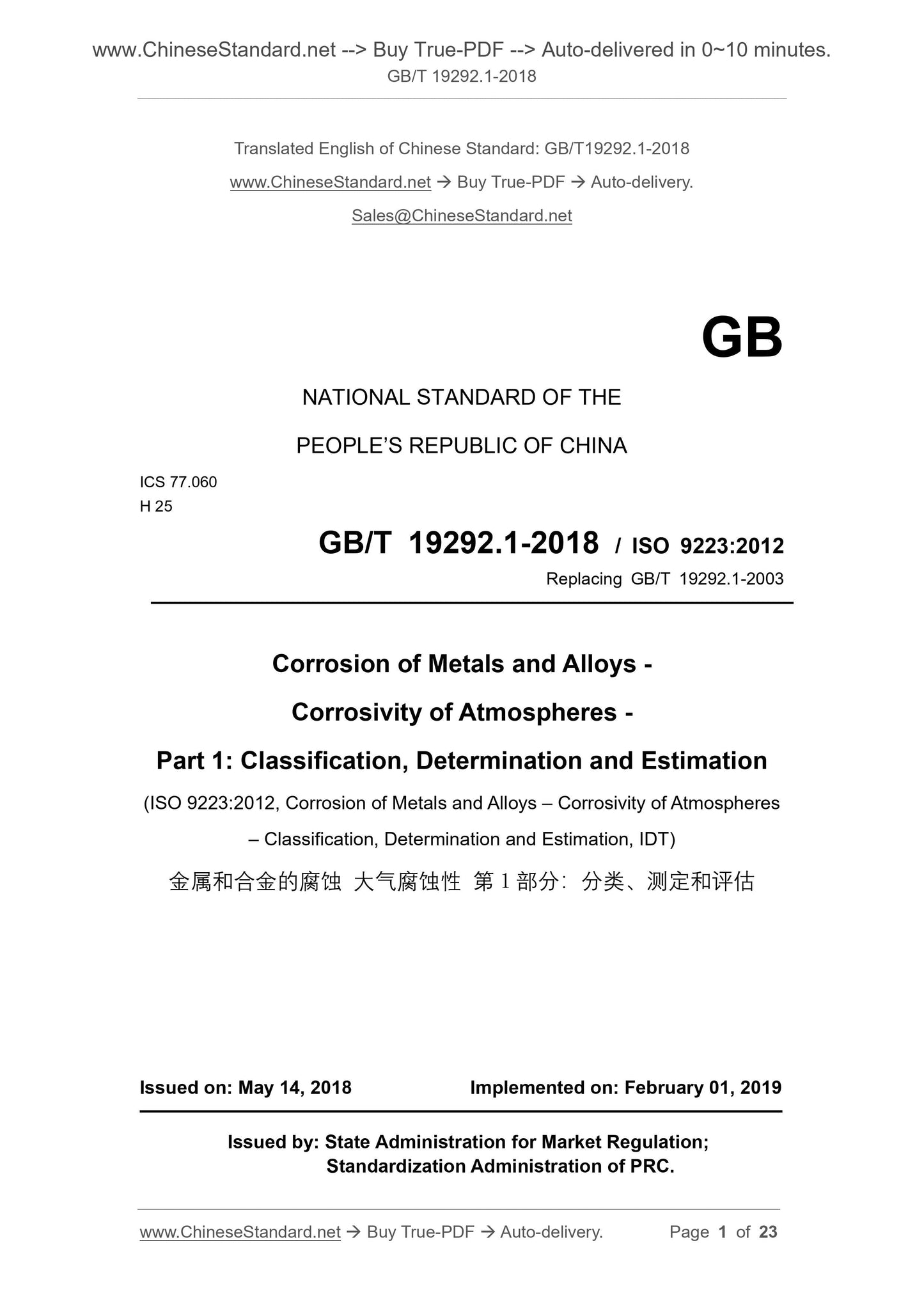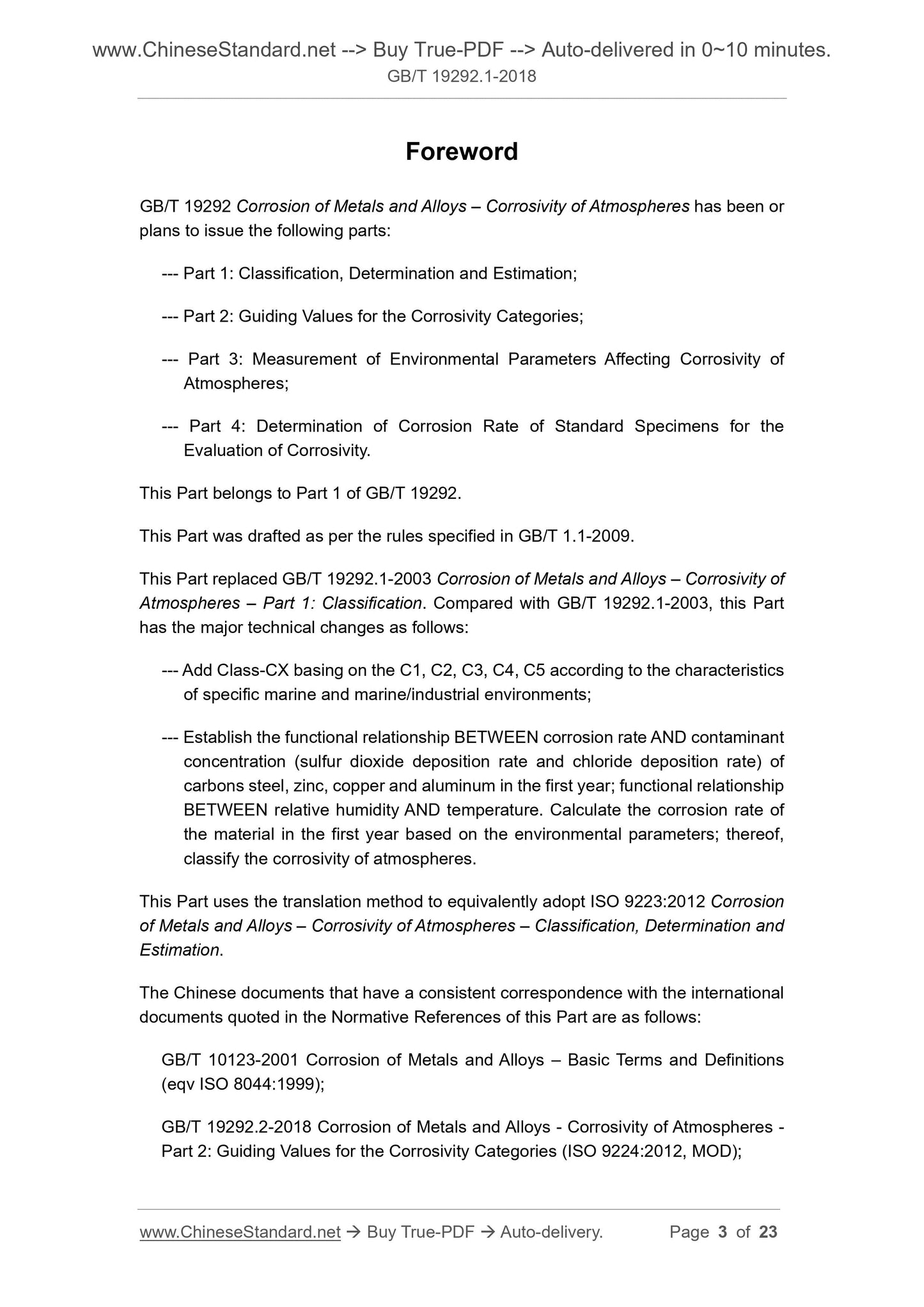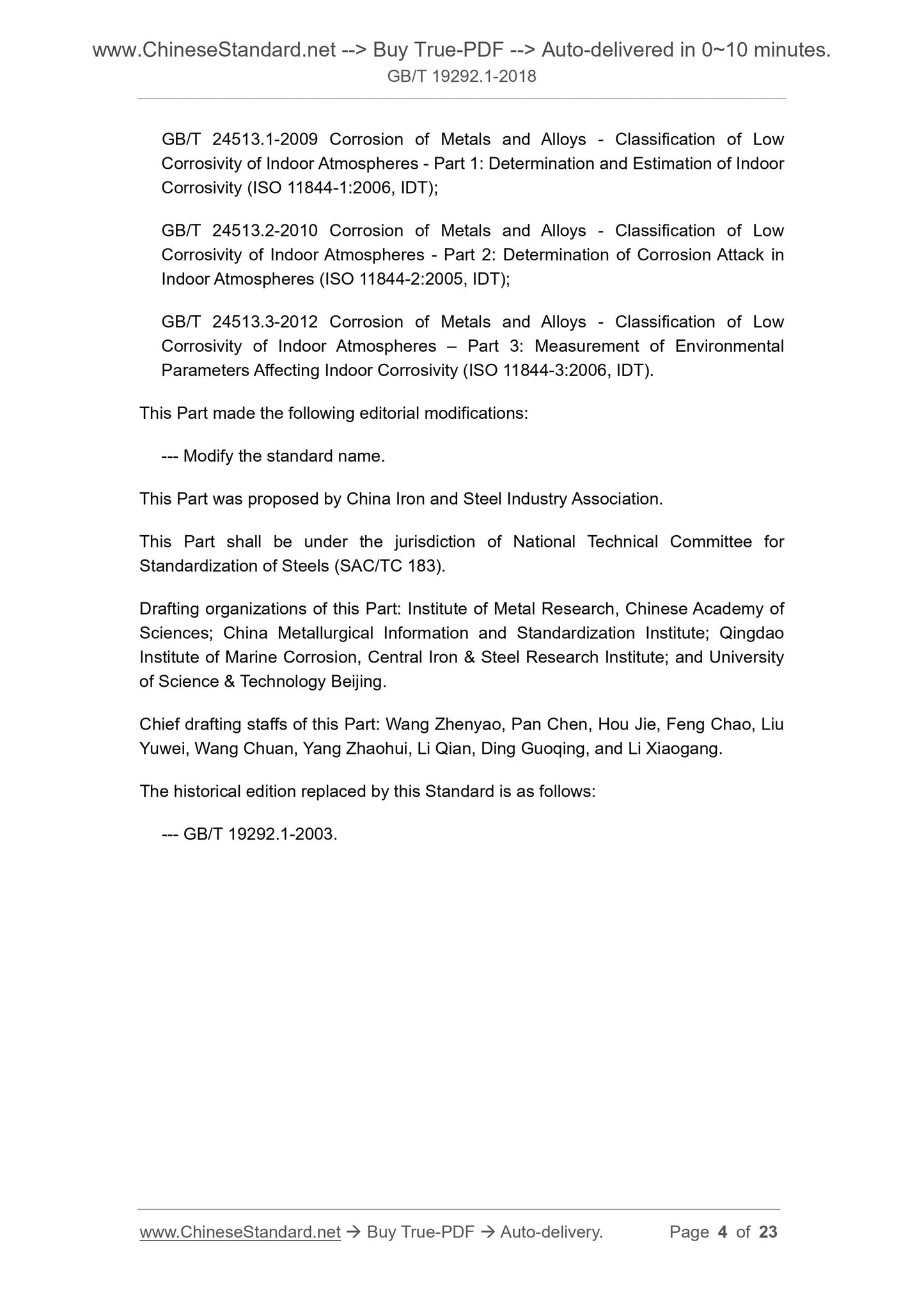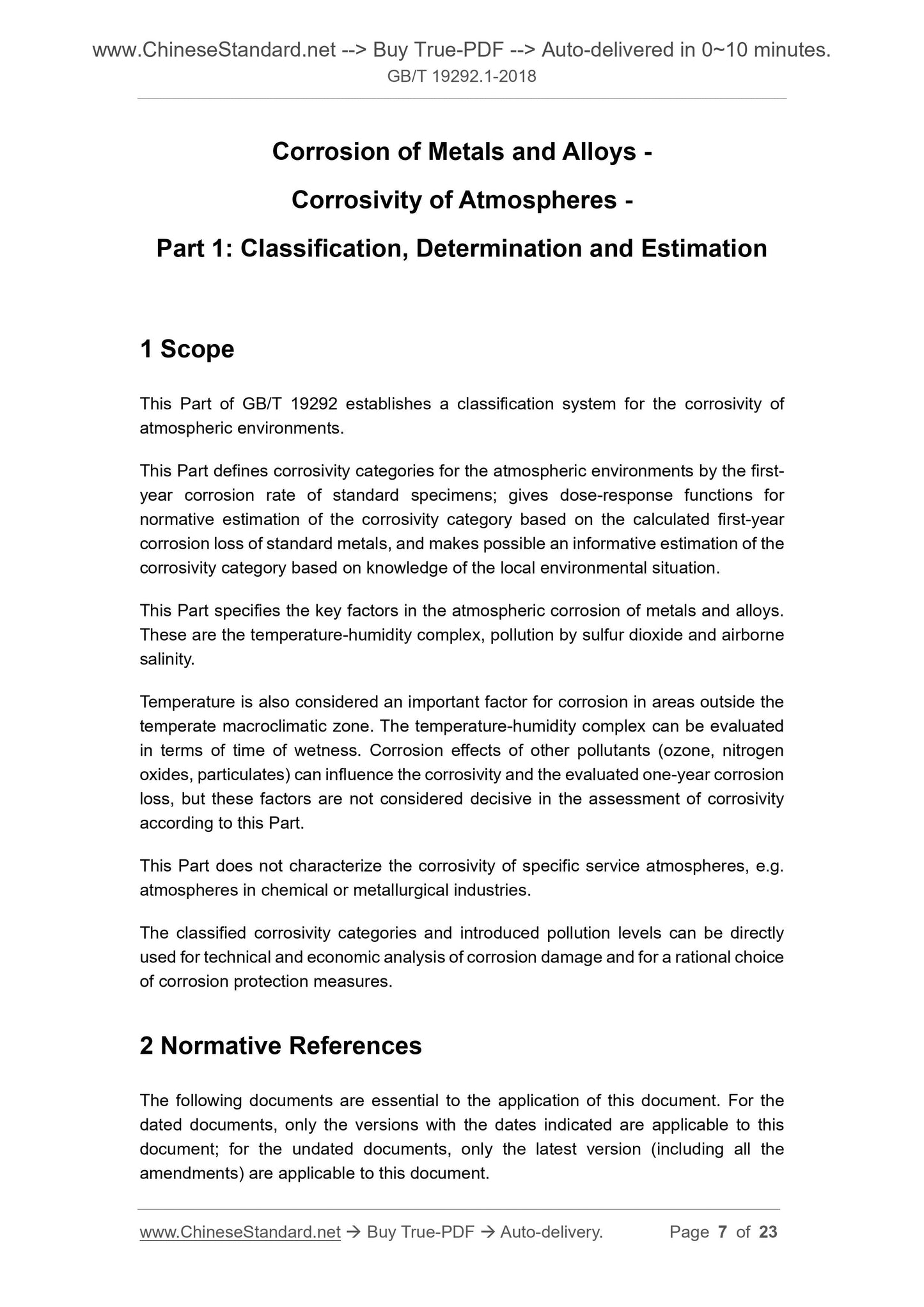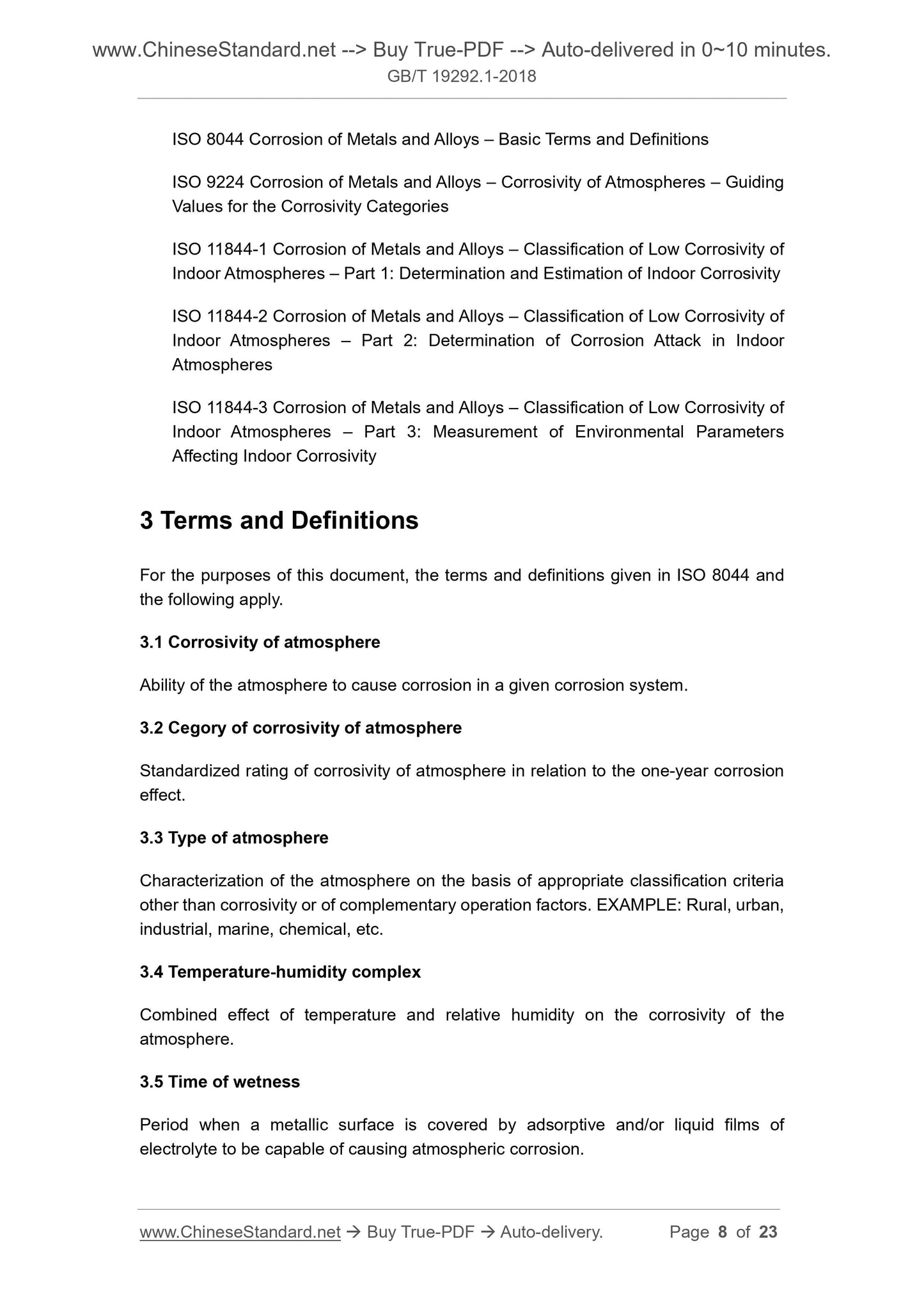1
/
of
6
PayPal, credit cards. Download editable-PDF and invoice in 1 second!
GB/T 19292.1-2018 English PDF (GBT19292.1-2018)
GB/T 19292.1-2018 English PDF (GBT19292.1-2018)
Regular price
$145.00 USD
Regular price
Sale price
$145.00 USD
Unit price
/
per
Shipping calculated at checkout.
Couldn't load pickup availability
Delivery: 3 seconds. Download true-PDF + Invoice.
Get QUOTATION in 1-minute: Click GB/T 19292.1-2018
Historical versions: GB/T 19292.1-2018
Preview True-PDF (Reload/Scroll if blank)
GB/T 19292.1-2018: Corrosion of metals and alloys -- Corrosivity of atmospheres -- Part 1: Classification, determination and estimation
GB/T 19292.1-2018
Corrosion of metals and alloys--Corrosivity of atmospheres--Part 1. Classification, determination and estimation
ICS 77.060
H25
National Standards of People's Republic of China
Replace GB/T 19292.1-2003
Corrosion of metals and alloys
Part 1. Classification, determination and evaluation
Part 1. Classification, determinationandestimation
(ISO 9223.2012, Corrosionofmetalsandaloys-Corrosivityofatmospheres-
Classification, determination andestimation, IDT)
Published on.2018-05-14
Implementation of.2019-02-01
State market supervision and administration
China National Standardization Administration issued
Foreword
GB/T 19292 "Corrosion of Atmospheric Corrosion of Metals and Alloys" has been or is planned to be released as follows.
--- Part 1. Classification, determination and evaluation;
--- Part 2. Guidance values for corrosion levels;
--- Part 3. Measurement of environmental parameters affecting atmospheric corrosivity;
--- Part 4. Determination of corrosion rate of standard samples for evaluation of corrosivity.
This part is the first part of GB/T 19292.
This part is drafted in accordance with the rules given in GB/T 1.1-2009.
This part replaces GB/T 19292.1-2003 "Classification of Corrosive Atmospheric Corrosion of Metals and Alloys". And GB/T 19292.1-
The main technical changes in.2003 are as follows.
--- Based on the characteristics of specific marine and marine/industrial environments, a first-class CX is added on the basis of C1, C2, C3, C4, C5;
--- Established the corrosion rate and pollutant concentration (sulphur dioxide deposition rate and chloride deposition rate) of carbon steel, zinc, copper and aluminum in the first year,
Relative humidity and temperature as a function of temperature. Calculate the corrosion rate of the material in the first year based on environmental parameters, and accordingly
Corrosive grading.
This section uses the translation method equivalent to ISO 9223.2012 "Corrosion of metals and alloys, atmospheric corrosion classification, determination and
Evaluation.
The documents of our country that have a consistent correspondence with the international documents referenced in this part are as follows.
GB/T 10123-2001 Basic terms and definitions for corrosion of metals and alloys (eqvISO 8044.1999);
GB/T 19292.2-2018 Corrosion of metals and alloys - Part 2. Guide to corrosion grades
(ISO 9224.2012, MOD);
GB/T 24513.1-2009 Corrosion of metals and alloys - Part 2
Determination and evaluation (ISO 11844-1.2006, IDT);
GB/T 24513.2-2010 Corrosion of metals and alloys - Part 2
Determination (ISO 11844-2.2005, IDT);
GB/T 24513.3-2012 Corrosion of metals and alloys - Part 2
Determination of environmental parameters of eclipse (ISO 11844-3.2006, IDT).
This section has made the following editorial changes.
--- Modified the standard name.
This part was proposed by the China Iron and Steel Association.
This part is under the jurisdiction of the National Steel Standardization Technical Committee (SAC/TC183).
This section drafted by. Institute of Metal Research, Chinese Academy of Sciences, Metallurgical Industry Information Standards Institute, Iron and Steel Research Institute Qingdao Ocean Corrosion
Institute, Beijing University of Science and Technology.
The main drafters of this section. Wang Zhenduo, Pan Chen, Hou Jie, Feng Chao, Liu Yuwei, Wang Chuan, Yang Zhaohui, Li Qian, Ding Guoqing, Li Xiaogang.
The previous versions of the standards replaced by this section are.
---GB/T 19292.1-2003.
introduction
When the surfaces of metals, alloys, and metal coatings are wet, they are subject to atmospheric corrosion. The nature and rate of erosion depends on the table
The nature of the surface to form an electrolyte depends, inter alia, on the type and amount of suspended contaminants in the atmosphere and on the time at which they act on the metal surface.
Corrosion patterns and corrosion rates are a combination of corrosion systems (including metallic materials, atmospheric environments, process parameters, and operating conditions).
result.
Corrosion grade is a technical feature that is used in special applications, especially in relation to service life, in atmospheric environments.
The choice of materials and protective measures provides the basis.
Atmospheric corrosivity data is critical to the development and specification of the best corrosion protection measures for a product.
Corrosion classification is determined according to the corrosion effect of the first year on the standard specimen specified in GB/T 19292.1. Corrosive classification can also be based on
The most important atmospheric factors affecting the corrosion of metals and alloys are evaluated.
GB/T 19292.3 specifies the measurement standards for relevant environmental parameters.
Figure 1 lists the corrosive classification methods for determining and evaluating a given location and their interrelationships according to this standard. It is used to distinguish corrosion measurements
Determination of corrosiveness is important. It distinguishes the corrosive assessment based on the application of the dose-response function and compares the typical atmosphere
Corrosion assessments of the environment are equally important.
This section does not consider the impact of product design and operating mode on corrosion resistance, as these factors are extremely special and cannot be used as usual.
Treated. GB/T 20852 specifies the selection steps for the best corrosion protection measures in the atmospheric environment.
Figure 1 Atmospheric Corrosion Classification
Corrosion of metals and alloys
Part 1. Classification, determination and evaluation
1 Scope
This part of GB/T 19292 establishes a classification system for the corrosiveness of the atmospheric environment.
This section defines the corrosive classification of the atmospheric environment according to the corrosion rate of the first year of the standard sample;
Annual corrosion weight loss gives a dose-response function for the normative assessment of corrosivity levels; corrosive based on local environmental conditions
Level data assessment is possible.
This section specifies the key factors for atmospheric corrosion of metals and alloys, including the combined effects of temperature and humidity, sulfur dioxide pollution and air.
Salt pollution.
Temperature is also considered to be an important factor in the corrosion of temperate climate zones. The combined effect of temperature and humidity can be assessed based on the wet time.
Corrosion of other contaminants (including ozone, nitrides, particulate matter) can affect corrosivity and estimated annual corrosion weight loss, but these factors
Not a decisive factor in the assessment of corrosion based on this section.
This section does not apply to atmospheric corrosiveness in special environments, such as chemical or metallurgical industrial atmospheres.
Corrosion grades and pollution levels can be directly used for technical and economic analysis of corrosion damage, as well as for the rational selection of corrosion protection measures.
2 Normative references
The following documents are indispensable for the application of this document. For dated references, only dated versions apply to this article.
Pieces. For undated references, the latest edition (including all amendments) applies to this document.
ISO 8044 Corrosion basic terms and definitions for metals and alloys (Corrosionofmetalsandaloys-Basicterms
Anddefinitions)
ISO 9224 Corrosion of Corrosive Atmosphere for Metals and Alloys (Corrosionofmetalsand
aloys-Co...
Get QUOTATION in 1-minute: Click GB/T 19292.1-2018
Historical versions: GB/T 19292.1-2018
Preview True-PDF (Reload/Scroll if blank)
GB/T 19292.1-2018: Corrosion of metals and alloys -- Corrosivity of atmospheres -- Part 1: Classification, determination and estimation
GB/T 19292.1-2018
Corrosion of metals and alloys--Corrosivity of atmospheres--Part 1. Classification, determination and estimation
ICS 77.060
H25
National Standards of People's Republic of China
Replace GB/T 19292.1-2003
Corrosion of metals and alloys
Part 1. Classification, determination and evaluation
Part 1. Classification, determinationandestimation
(ISO 9223.2012, Corrosionofmetalsandaloys-Corrosivityofatmospheres-
Classification, determination andestimation, IDT)
Published on.2018-05-14
Implementation of.2019-02-01
State market supervision and administration
China National Standardization Administration issued
Foreword
GB/T 19292 "Corrosion of Atmospheric Corrosion of Metals and Alloys" has been or is planned to be released as follows.
--- Part 1. Classification, determination and evaluation;
--- Part 2. Guidance values for corrosion levels;
--- Part 3. Measurement of environmental parameters affecting atmospheric corrosivity;
--- Part 4. Determination of corrosion rate of standard samples for evaluation of corrosivity.
This part is the first part of GB/T 19292.
This part is drafted in accordance with the rules given in GB/T 1.1-2009.
This part replaces GB/T 19292.1-2003 "Classification of Corrosive Atmospheric Corrosion of Metals and Alloys". And GB/T 19292.1-
The main technical changes in.2003 are as follows.
--- Based on the characteristics of specific marine and marine/industrial environments, a first-class CX is added on the basis of C1, C2, C3, C4, C5;
--- Established the corrosion rate and pollutant concentration (sulphur dioxide deposition rate and chloride deposition rate) of carbon steel, zinc, copper and aluminum in the first year,
Relative humidity and temperature as a function of temperature. Calculate the corrosion rate of the material in the first year based on environmental parameters, and accordingly
Corrosive grading.
This section uses the translation method equivalent to ISO 9223.2012 "Corrosion of metals and alloys, atmospheric corrosion classification, determination and
Evaluation.
The documents of our country that have a consistent correspondence with the international documents referenced in this part are as follows.
GB/T 10123-2001 Basic terms and definitions for corrosion of metals and alloys (eqvISO 8044.1999);
GB/T 19292.2-2018 Corrosion of metals and alloys - Part 2. Guide to corrosion grades
(ISO 9224.2012, MOD);
GB/T 24513.1-2009 Corrosion of metals and alloys - Part 2
Determination and evaluation (ISO 11844-1.2006, IDT);
GB/T 24513.2-2010 Corrosion of metals and alloys - Part 2
Determination (ISO 11844-2.2005, IDT);
GB/T 24513.3-2012 Corrosion of metals and alloys - Part 2
Determination of environmental parameters of eclipse (ISO 11844-3.2006, IDT).
This section has made the following editorial changes.
--- Modified the standard name.
This part was proposed by the China Iron and Steel Association.
This part is under the jurisdiction of the National Steel Standardization Technical Committee (SAC/TC183).
This section drafted by. Institute of Metal Research, Chinese Academy of Sciences, Metallurgical Industry Information Standards Institute, Iron and Steel Research Institute Qingdao Ocean Corrosion
Institute, Beijing University of Science and Technology.
The main drafters of this section. Wang Zhenduo, Pan Chen, Hou Jie, Feng Chao, Liu Yuwei, Wang Chuan, Yang Zhaohui, Li Qian, Ding Guoqing, Li Xiaogang.
The previous versions of the standards replaced by this section are.
---GB/T 19292.1-2003.
introduction
When the surfaces of metals, alloys, and metal coatings are wet, they are subject to atmospheric corrosion. The nature and rate of erosion depends on the table
The nature of the surface to form an electrolyte depends, inter alia, on the type and amount of suspended contaminants in the atmosphere and on the time at which they act on the metal surface.
Corrosion patterns and corrosion rates are a combination of corrosion systems (including metallic materials, atmospheric environments, process parameters, and operating conditions).
result.
Corrosion grade is a technical feature that is used in special applications, especially in relation to service life, in atmospheric environments.
The choice of materials and protective measures provides the basis.
Atmospheric corrosivity data is critical to the development and specification of the best corrosion protection measures for a product.
Corrosion classification is determined according to the corrosion effect of the first year on the standard specimen specified in GB/T 19292.1. Corrosive classification can also be based on
The most important atmospheric factors affecting the corrosion of metals and alloys are evaluated.
GB/T 19292.3 specifies the measurement standards for relevant environmental parameters.
Figure 1 lists the corrosive classification methods for determining and evaluating a given location and their interrelationships according to this standard. It is used to distinguish corrosion measurements
Determination of corrosiveness is important. It distinguishes the corrosive assessment based on the application of the dose-response function and compares the typical atmosphere
Corrosion assessments of the environment are equally important.
This section does not consider the impact of product design and operating mode on corrosion resistance, as these factors are extremely special and cannot be used as usual.
Treated. GB/T 20852 specifies the selection steps for the best corrosion protection measures in the atmospheric environment.
Figure 1 Atmospheric Corrosion Classification
Corrosion of metals and alloys
Part 1. Classification, determination and evaluation
1 Scope
This part of GB/T 19292 establishes a classification system for the corrosiveness of the atmospheric environment.
This section defines the corrosive classification of the atmospheric environment according to the corrosion rate of the first year of the standard sample;
Annual corrosion weight loss gives a dose-response function for the normative assessment of corrosivity levels; corrosive based on local environmental conditions
Level data assessment is possible.
This section specifies the key factors for atmospheric corrosion of metals and alloys, including the combined effects of temperature and humidity, sulfur dioxide pollution and air.
Salt pollution.
Temperature is also considered to be an important factor in the corrosion of temperate climate zones. The combined effect of temperature and humidity can be assessed based on the wet time.
Corrosion of other contaminants (including ozone, nitrides, particulate matter) can affect corrosivity and estimated annual corrosion weight loss, but these factors
Not a decisive factor in the assessment of corrosion based on this section.
This section does not apply to atmospheric corrosiveness in special environments, such as chemical or metallurgical industrial atmospheres.
Corrosion grades and pollution levels can be directly used for technical and economic analysis of corrosion damage, as well as for the rational selection of corrosion protection measures.
2 Normative references
The following documents are indispensable for the application of this document. For dated references, only dated versions apply to this article.
Pieces. For undated references, the latest edition (including all amendments) applies to this document.
ISO 8044 Corrosion basic terms and definitions for metals and alloys (Corrosionofmetalsandaloys-Basicterms
Anddefinitions)
ISO 9224 Corrosion of Corrosive Atmosphere for Metals and Alloys (Corrosionofmetalsand
aloys-Co...
Share
